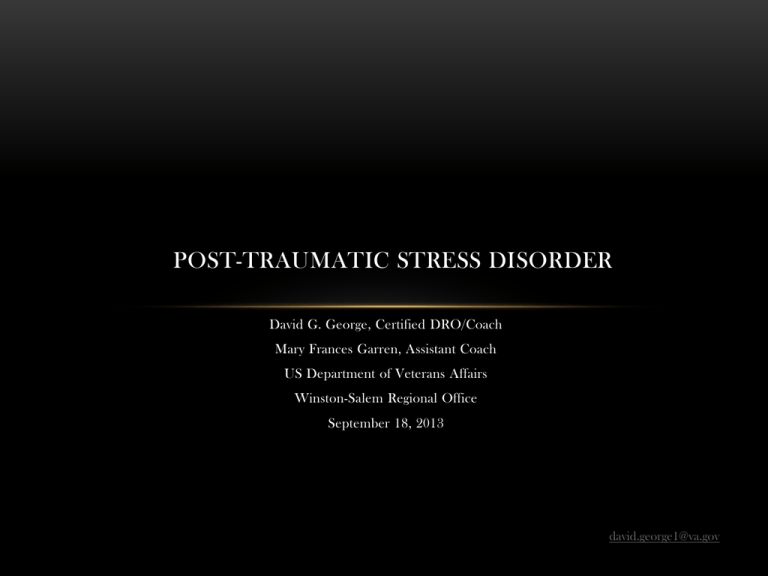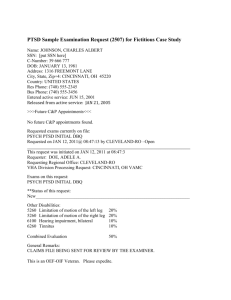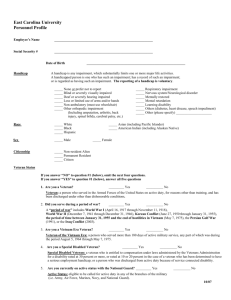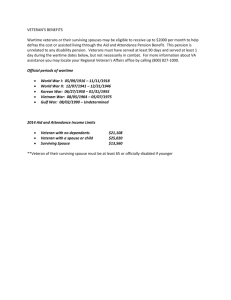Evaluating mental health disabilities
advertisement

POST-TRAUMATIC STRESS DISORDER David G. George, Certified DRO/Coach Mary Frances Garren, Assistant Coach US Department of Veterans Affairs Winston-Salem Regional Office September 18, 2013 david.george1@va.gov POST-TRAUMATIC STRESS DISORDER (PTSD) • Before a veteran can receive compensation for PTSD, they must meet the following criteria outlined in 38 CFR 3.304(f): • 1. A diagnosis of PTSD in accordance with DSM-IV. • 2. An in-service, “stressor.” • 3. A link between the diagnosis and the in-service, “stressor.” • These requirements are negated under the following circumstances: • 1. If the veteran was diagnosed with PTSD while on active duty. • 2. Service treatment records show symptoms of PTSD prior to discharge and a link is established between these symptoms and the current diagnosis of PTSD. THE IN-SERVICE “STRESSOR” • The in-service, “stressor” can be any event in which a veteran experienced, witnessed, or was confronted with an event that involved actual or threatened death or serious injury, or a threat to the physical integrity of self or others. For VBA purposes, these stressors fall into the following categories: • 1. Combat. • 2. The Prisoner of War (POW) experience. • 3. Personal trauma to include sexual trauma/harassment (non-combat). • 4. Fear. COMBAT • Combat is defined as direct participation in battle against an enemy. This is often referred to as an “automatic stressor.” • Combat is indicated by the receipt of specific medals: Combat Infantryman Badge/Combat Action Badge/Combat Medical Badge Purple Heart Silver Star/Distinguished Flying Cross Bronze Star or branch-specific Commendation Medal (w/ “V” device) • The receipt of these medals is verified via the veteran’s DD-214 and/or service personnel records (201 file). • Unit awards, such as the Vietnam Gallantry Cross , obtained by an individual are not considered combat awards for VA purposes. THE PRISONER OF WAR EXPERIENCE • An in-service stressor may be conceded for a veteran that is determined to be a former prisoner of war (POW), provided the claimed stressor is consistent with the hardships of the experience. • A POW is defined as any person forcibly detained/interned in the line of duty by an enemy or foreign government, the agents of either, or a hostile force (see 38 CFR 3.1(y)). • The DoD maintains a database of all service members who were POWs. VA will accept these findings as proof of captivity. • If a veteran alleges captivity and there is no record of such, VA can establish POW status, but only at the discretion of the Director of VA’s Compensation and Pension Service. • Being arrested or detained by a foreign government for a violation of law will not establish POW status. PERSONAL TRAUMA • Other military experiences may result in a diagnosis of PTSD. • These non-combat stressors are the most difficult to verify as the historical record often contains little to no evidence of the event having actually occurred. • Types of personal trauma include: Physical assault (sexual and non-sexual) Sexual harassment, discrimination, and other forms of psychological abuse Injuries (car accidents, burns, etc.) Occupational exposure (EMTs, MPs, nurses, physicians, etc.) Tragedies (plane crash, building collapse, etc.) PERSONAL TRAUMA • Verification of a non-combat stressor may require evidence from a variety of sources, including, but certainly not limited to: • Police reports • Media (television, Internet articles, newspaper clippings, photographs, Facebook posts, etc.) • Medical and psychiatric reports • Lay statements from family, friends, clergy, or acquaintances • The absence of evidence is not negative evidence. FEAR… • Compensation may also be paid for PTSD if a veteran identifies fear of hostile military or terrorist activity as their in-service, “stressor.” • “Fear of hostile military or terrorist activity," is defined as experiencing, witnessing, or being confronted by an event or circumstance that involved actual or threatened death or serious injury, or a threat to the physical integrity of the veteran or others due to an actual or potential improvised explosive device (IED), vehicle-imbedded explosive device (car bomb), incoming artillery, rocket, or mortar fire, grenades, small arms fire (including suspected or actual) sniper fire, or an attack on friendly military aircraft, and the veteran's response to the event or circumstance involved a psychological or psycho-physiological state of fear, helplessness, or horror. • The veteran’s statement alone can verify the events actually occurred provided his or her testimony is consistent with his or her service. QUESTIONS? EVALUATING PTSD GENERAL REGULATORY CONSIDERATIONS 38 CFR 4.3: It is the defined and consistently applied policy of the Department of Veterans Affairs to administer the law under a broad interpretation, consistent, however, with the facts shown in every case. When after careful consideration of all procurable and assembled data, a reasonable doubt arises regarding the degree of disability such doubt will be resolved in favor of the claimant. 38 CFR 4.7: Where there is a question as to which of two evaluations shall be applied, the higher evaluation will be assigned if the disability picture more nearly approximates the criteria required for that rating. Otherwise, the lower rating will be assigned. EVALUATING PTSD SPECIFIC REGULATORY CONSIDERATIONS 38 CFR 4.126 Evaluation of disability from mental disorders (a) When evaluating a mental disorder, the rating agency shall consider the frequency, severity, and duration of psychiatric symptoms, the length of remissions, and the veteran's capacity for adjustment during periods of remission. The rating agency shall assign an evaluation based on all the evidence of record that bears on occupational and social impairment rather than solely on the examiner's assessment of the level of disability at the moment of the examination. (b) When evaluating the level of disability from a mental disorder, the rating agency will consider the extent of social impairment, but shall not assign an evaluation solely on the basis of social impairment. (c) Delirium, dementia, and amnestic and other cognitive disorders shall be evaluated under the general rating formula for mental disorders; neurologic deficits or other impairments stemming from the same etiology (e.g., a head injury) shall be evaluated separately and combined with the evaluation for delirium, dementia, or amnestic or other cognitive disorder (see §4.25). (d) When a single disability has been diagnosed both as a physical condition and as a mental disorder, the rating agency shall evaluate it using a diagnostic code which represents the dominant (more disabling) aspect of the condition (see §4.14). (Authority: 38 U.S.C. 1155) GENERAL RATING FORMULA FOR MENTAL DISORDERS • All psychiatric disorders are evaluated using the, “General Rating Formula for Mental Disorders” found in 38 CFR 4.130. • This “formula” provides criteria for 0, 10, 30, 50, 70, and 100 percent evaluations. • For a single veteran with no dependents, the following are the monthly payment rates for the percentages listed above: • 10% = $129.00 • 30% = $395.00 • 50% = $810.00 • 70% = $1,293.00 • 100%= $2,816.00 CRITERIA FOR A 10% EVALUATION • Requirement for continuous medication (e.g., Zoloft, Celexa, Wellbutrin) OR • Mild or transient symptoms which decrease work efficiency and the ability to perform occupational tasks only during periods of significant stress • If neither criteria are met, 38 CFR Part 4 indicates a 0 percent evaluation is to be assigned. A 0 percent evaluation awards no monetary benefits, but does render the veteran eligible for healthcare for the service connected disability. CRITERIA FOR A 30% EVALUATION • Occupational and social impairment with an occasional decrease in work efficiency and intermittent periods of an inability to perform occupational tasks (although generally functioning satisfactorily, with routine behavior, self-care, and normal conversation), due to such symptoms as: • Depressed mood • Anxiety • Suspiciousness • Panic/anxiety attacks (weekly or less often) • Chronic sleep impairment • Mild memory loss (e.g., forgetting names, directions, recent events) CRITERIA FOR A 50% EVALUATION • Occupational and social impairment with reduced reliability and productivity due to such symptoms as: • Flattened affect • Circumstantial, circumlocutory, or stereotyped speech • Panic attacks more than once per week • Difficulties understanding complex commands • Impairment of short- and long-term memory • Impaired judgment • Impaired abstract thinking • Disturbances of motivation and mood • Difficulties establishing and maintaining work and social relationships CRITERIA FOR A 70% EVALUATION • Occupational and social impairment, with deficiencies in most areas, such as work, school, family relations, judgment, thinking, or mood, due to such symptoms as: • Suicidal ideation • Obsessional rituals that interfere with routine activities • Illogical, obscure, or irrelevant speech • Near-continuous panic or depression which affects independent functioning • Impaired impulse control (e.g., unprovoked irritability with violence) • Spatial disorientation • Neglect of personal appearance and hygiene • Difficulty adapting to stressful circumstances at work or in a work-like setting • Inability to establish and maintain relationships CRITERIA FOR A 100% EVALUATION • TOTAL Occupational and social impairment, due to such symptoms as: • Grossly impaired thought processes • Grossly impaired communication • Grossly inappropriate behavior • Persistent danger of hurting self or others • Intermittent ability to perform the activities of daily living • Disorientation to time and/or place • Loss of memory for names of close relatives, occupation, or his/her own name THE EVALUATION BUILDER • The Evaluation Builder (EB) is a rules-based calculator to improve both the quality and efficiency of decisions. • The EB was designed to provide the highest evaluation possible by automatically applying 38 CFR 4.7 and the US Court of Appeals for Veterans Claims’ decision in Tatum v. Shinseki . • The EB is not a “plug and play” tool, raters must still evaluate all the evidence of record to arrive at the proper evaluation. The EB disclaimer: The mental calculator produces a suggestion only, based on data entered. However, this suggestion is not meant to replace the judgment of the decision maker and a review and weighing of the evidence is required. • 38 CFR 4.126(a) does not allow a rater to simply assign an evaluation based off the DBQ. It states: The rating agency shall assign an evaluation based on all the evidence of record that bears on occupational and social impairment rather than solely on the examiner's assessment of the level of disability at the moment of the examination. INDIVIDUAL UNEMPLOYABILITY (IU) • A 100% evaluation can only be assigned if the veteran has BOTH total occupational AND social impairment. • If a veteran has a 70 percent evaluation for a mental disorder, but is shown to have total occupational impairment, VA will award a total evaluation based on unemployability (TDIU or IU). • IU pays at the same rate as a 100 percent evaluation. • If a veteran becomes gainfully employed , IU will be terminated. • IU cannot be awarded for the 10, 30, or 50 percent evaluations unless approved by the Director of the Compensation and Pension Service. CO-MORBIDITY • 38 CFR 4.14 prohibits compensation to be paid for two or more disabilities that affect the same body “part” and cause the same symptomatology. This is called, “pyramiding” and is a violation of Federal law. • If a veteran is diagnosed with two or more mental disorders, and those mental disorders are deemed service-connected, a veteran receives only one evaluation even if the symptomatology can be delineated. • If a veteran has both a traumatic brain injury and a psychiatric disorder, and symptoms cannot be delineated, only one evaluation can be assigned. If symptoms can be delineated, separate evaluations may be assigned. • If a condition manifests as both a mental disorder and a physical disorder (e.g., conversion disorder, somatization disorder), VA will compensate the most disabling manifestation. OTHER FYIS • When a veteran is evaluated as 100% disabled due to a mental disorder, VBA must consider whether or not the veteran is competent to handle the disbursements of funds without limitation. • When a veteran is evaluated as 100% disabled due to a mental disorder, and it is determined that the condition will not improve, basic eligibility to Dependents’ Educational Assistance (DEA) is established (see 38 USC Chapter 35). • VBA does not subtract the Global Assessment of Functioning (GAF) score from 100 to arrive at the veteran’s evaluation and policy prohibits the use of a GAF as either the sole or primary determining factor for a disability evaluation. • NATIONAL CENTER FOR PTSD: http://www.ptsd.va.gov/ • DBQs: http://www.benefits.va.gov/compensation/dbq_VSOinstruct.asp QUESTIONS?


